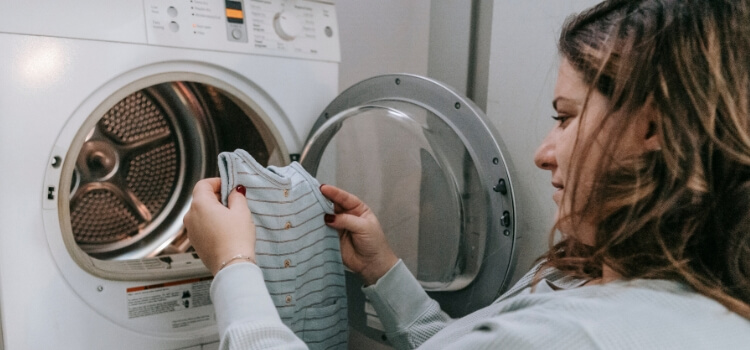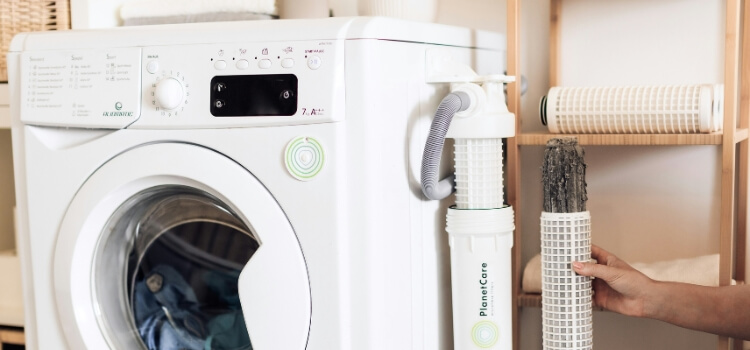As an Amazon Associate, I earn from qualifying purchases
To winterize a washing machine, drain all water, disconnect hoses, and clean the drum thoroughly. Winterizing prevents freezing.
As the temperature drops, it’s essential to prepare your washing machine for the colder months to avoid damage and ensure it runs smoothly when needed. Taking a few simple steps can help protect your appliance from freezing temperatures. By properly winterizing your washing machine, you can prolong its lifespan and avoid costly repairs.
Let’s explore the steps you can take to safeguard your washing machine during the winter season.

Introduction To Winterizing Your Washing Machine
Prepare your washing machine for winter by following these simple steps: Turn off the water supply, disconnect hoses, drain the water, and clean the drum. By winterizing your washing machine, you can prevent damage from freezing temperatures and ensure its longevity.
It’s crucial to take the necessary precautions as the winter months approach to safeguard your washing machine from potential damage from freezing temperatures. Winterizing your washing machine involves a series of simple steps that can help prevent costly repairs and extend the lifespan of your appliance. In this article, we will cover why winterizing is necessary, the benefits of winterizing, and the steps you can take to ensure your washing machine is winter-ready.
Why Winterize?
Winterizing your washing machine is crucial because water left inside the appliance can freeze and cause damage to the internal components. This can lead to leaks, cracks, and even a complete breakdown of your washing machine. Additionally, water left inside the machine can promote the growth of mold and mildew, which can be hazardous to your health. Winterizing your washing machine can help prevent these issues and ensure that your appliance continues to function properly.
Benefits Of Winterizing
Winterizing your washing machine has several benefits. First and foremost, it can help prevent costly repairs caused by frozen pipes or damaged components. By taking the time to winterize your washing machine, you can avoid the expense of hiring a technician to fix any issues that may arise. Additionally, winterizing your washing machine can help extend the lifespan of your appliance by preventing unnecessary wear and tear. Finally, winterizing your washing machine can help improve the quality of your laundry by preventing mold and mildew growth.
To winterize your washing machine, you’ll need to follow a few simple steps. These include draining the water from the machine, disconnecting hoses, and adding antifreeze to the internal components. By taking the time to winterize your washing machine, you can ensure that it continues to function properly for years to come.

Tools And Materials Needed
Before winterizing your washing machine, it’s essential to gather the right tools and materials to ensure a smooth and efficient process. Here’s a list of essential supplies and tips for choosing the right antifreeze.
List Of Essential Supplies
When preparing to winterize your washing machine, it’s important to have the following supplies on hand:
- Adjustable wrench
- Bucket
- Towels or rags
- Antifreeze
- Plastic bags
- Tape
- Owner’s manual
Choosing The Right Antifreeze
Selecting the appropriate antifreeze is crucial for protecting your washing machine during the winter months. Consider the following factors when choosing the right antifreeze:
- Type: Ensure you choose antifreeze specifically designed for washing machines.
- Non-Toxic: Opt for non-toxic antifreeze to prevent any harmful effects on the environment and your washing machine.
- Quantity: Refer to the owner’s manual for guidance on the appropriate amount of antifreeze needed.
Step-by-step Guide To Winterizing
When preparing your washing machine for winter, it’s crucial to follow a few key steps to protect it from potential damage caused by freezing temperatures. Here is a simple guide to help you winterize your washing machine effectively.
Turning Off The Water Supply
Before winter arrives, locate the shut-off valve for your washing machine’s water supply. Turn it off to prevent water from flowing into the machine during the winter.
Draining The Hoses And Pipes
Next, disconnect the hoses from the back of the washing machine. Drain any remaining water from both the hoses and the pipes to avoid freezing and potential damage.
Adding Antifreeze
Finally, consider adding antifreeze to the drain pump and internal components of the washing machine. This will help prevent any remaining water from freezing and causing issues.
Cleaning Before Winterization
Before winterizing your washing machine, it’s important to give it a thorough cleaning. This will help ensure that it’s in top condition when you’re ready to use it again. By following a few simple steps, you can deep clean the drum, wipe down gaskets and seals, and prevent any potential issues that could arise during the winter months.
Deep Cleaning The Drum
To deep clean the drum, start by running a hot water cycle with a cup of white vinegar. This will help remove any built-up detergent residue and mildew. Then, wipe down the inside of the drum with a mixture of hot water and mild detergent. Finally, run a rinse cycle to ensure that the drum is thoroughly clean and free of any remaining residue.
Wiping Down Gaskets And Seals
Next, it’s important to pay attention to the gaskets and seals on your washing machine. Use a damp cloth and mild detergent to wipe down these areas, paying close attention to any crevices where dirt and grime can accumulate. This will help prevent mold and mildew from forming and ensure that your machine remains in good working condition.

Protecting The Washing Machine’s Exterior
Protecting the Washing Machine’s Exterior is crucial for keeping it in top condition throughout the winter months. You can prevent the harsh winter weather from causing damage to your washing machine by adhering to a few straightforward guidelines and tips. In this section, we will explore the essential steps to safeguard the exterior of your washing machine during the winter season.
Covering Tips
When it comes to protecting your washing machine’s exterior, investing in a high-quality cover is essential. Look for a cover that is specifically designed for washing machines and provides a snug fit. Ensure that the cover is made from durable, weather-resistant material to shield the machine from rain, snow, and wind. Additionally, opt for a cover with a secure fastening mechanism to prevent it from being blown off in strong winds.
Ideal Storage Conditions
Storing the washing machine in an ideal location is essential for its protection during the winter. If possible, consider moving the machine to a sheltered area, such as a garage or a covered patio. This will shield the appliance from direct exposure to the elements, minimizing the risk of damage. Avoid placing the washing machine in areas prone to temperature fluctuations, as extreme cold can adversely affect its components.
Restarting Your Machine After Winter
After a long winter, it’s crucial to properly restart your washing machine before using it. Follow these steps to ensure efficient operation:
- Inspect hoses and connections for leaks or damage.
- Run a maintenance cycle to clean the machine.
- Plug in the machine and ensure it’s grounded.
- Check the water inlet filters for debris.
- Inspect the drain pump for any blockages.
- Test the machine by running a short cycle.
Proper maintenance is key to extending the life of your washing machine.
Common Mistakes To Avoid
When winterizing your washing machine, it’s crucial to avoid common mistakes that can lead to costly repairs. Ignoring the filters, overusing antifreeze, and neglecting proper drainage are some of the pitfalls to steer clear of. By being mindful of these blunders, you can ensure the longevity and efficiency of your washing machine during the winter season.
Ignoring The Filters
One of the most frequently overlooked tasks when winterizing a washing machine is cleaning or replacing the filters. Ignoring this essential step can result in clogs and decreased water flow, leading to poor performance and potential damage. Regularly checking and cleaning the filters before the arrival of winter is imperative to maintain the optimal functioning of your washing machine.
Overusing Antifreeze
While antifreeze is a vital component in winterizing certain appliances, it’s important to use it sparingly and with caution. Overusing antifreeze in your washing machine can lead to excessive foaming and damage to the machine’s components. It’s crucial to follow the manufacturer’s guidelines and only use the recommended amount of antifreeze to prevent potential issues and ensure the safe operation of your washing machine during the winter months.
Other Tips For Winterizing Your Washing Machine
Here are some additional tips to keep in mind when winterizing your washing machine:
- Turn off the water supply to the machine and disconnect the hoses.
- Drain any remaining water from the hoses and the machine.
- Add antifreeze to the drum to prevent any remaining water from freezing.
- Protect the machine from extreme temperatures by covering it with a blanket or tarp.
- Keep the machine in a dry and cool place to prevent rust and corrosion.
By following these simple steps, you can winterize your washing machine and protect it from the harsh winter weather. Taking these precautions will ensure that your machine lasts longer and runs smoothly.

Frequently Asked Questions
To protect your washing machine in freezing weather, insulate exposed pipes, keep the area warm, and run a small amount of water. Additionally, consider using a space heater or heat lamp nearby. Regularly check for leaks or damage to ensure optimal performance.
To prevent washing machine pipes from freezing, insulate them with foam sleeves. Keep the area warm and consider using a space heater. Allow a small trickle of water to run through the pipes during cold spells. Disconnect and drain the hoses if the machine won’t be used for an extended period.
Winterizing a washing machine prevents freezing damage during cold months, ensuring optimal performance.
To winterize, disconnect hoses, drain water, clean drum, and leave door ajar to prevent mold.
Do not use antifreeze in a washing machine, as it can be harmful and dangerous.
Conclusion
Winterizing your washing machine is essential for preventing damage in cold weather. By following the simple steps outlined in this post, you can ensure that your machine remains in good working condition throughout the winter months. Taking the time to prepare your washing machine for winter will save you from costly repairs and prolong its lifespan.
As an Amazon Associate, I earn from qualifying purchases
Leave a Reply